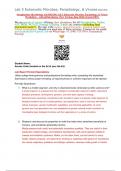Lab 5 Eukaryotic Microbes, Parasitology, & Viruses BIO250L”
Straighterline Microbiology Lab BIO250L Lab 5 Eukaryotic Microbes, Parasitology, & Viruses
Worksheet – with all lab photos (New Version June 2024) Scored 100%
We are a team of experts offering class attendance for all Straighterline, Online
ATI, HESI, NCLEX, Portage Learning, Sophia etc courses (including final
proctored exams!!). We also write essays, discussion posts, research papers and
school assignments. Should you need any of these services, Contact us via email:
merchantmuchiri@gmail.com or WhatsApp: +1 (540) 753-5914. Guaranteed
Passing!
Student Name:
Access Code (located on the lid of your lab kit):
Lab Report Format Expectations
Utilize college level grammar and professional formatting when completing this worksheet.
Submissions without proper formatting, all required photos or sufficient responses will be rejected.
Pre-lab Questions
1. What is a model organism, and why is Saccharomyces cerevisiae so often used as one?
A model organism is a species that has undergone considerable research to better understand
biological processes, development, genetics, and other basic aspects of biology.
Saccharomyces cerevisiae, sometimes known as baker's yeast, is a popular model organism for
biological research due to its simple genetics, fast reproduction, ease of culturing, well-defined
cellular processes, genetic modification capabilities, and industrial applicability. Its small
genome size, fast generation time, and adaptability to genetic methods make it excellent for
investigating basic biological functions and their applications in a variety of sectors.
2. Research and discuss the properties of mold that make them sometimes beneficial to
humans, and sometimes potentially harmful.
Molds possess both useful and potentially hazardous qualities. They are useful in food
production, biotechnology, and medicine development, with some species utilized in
cheese and antibiotic synthesis. Molds, on the other hand, can be harmful to one's
health, destroy property, and spoil food. Inhaling or ingesting mold spores or mycotoxins
can cause respiratory problems and allergic reactions, whereas mold growth in interior
, environments can impair air quality and harm structures. Mold development must be
managed properly to avoid negative consequences.
3. The lab guide discussed “acellular” organisms. What characteristics classify them as
acellular? Would you consider these living organisms?
Acellular organisms, or acellular entities, lack a cellular structure composed of individual
cells with a plasma membrane and organelles. Instead, they are often made up of non-
cellular structures like viruses and prions. They have certain features of life, such as the
ability to evolve and proliferate, but lack others, such as cellular structure and independent
metabolism. As a result,it is argued that acellular organisms are not true living beings but
rather biological entities that exist on the border between living and nonliving matter.




